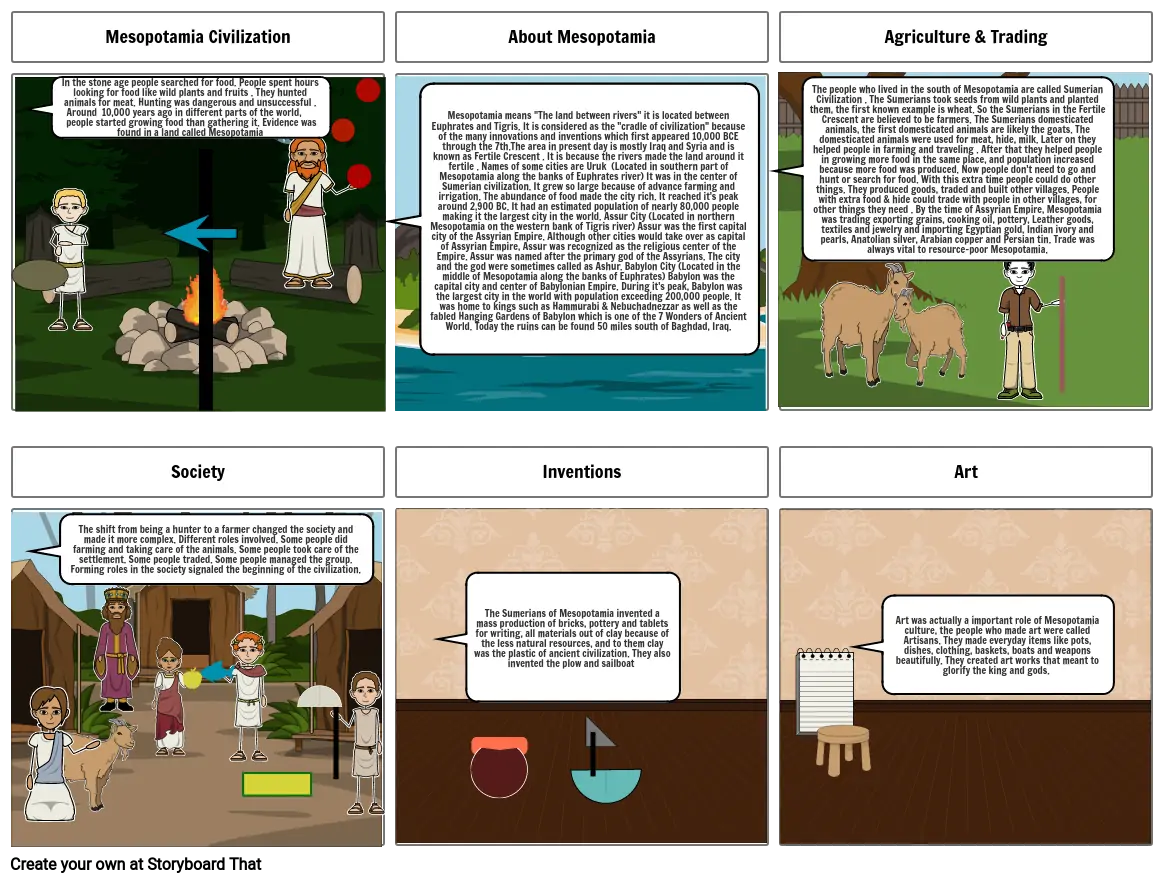Mesopotamia Civilization

Storyboard Text
- Mesopotamia Civilization
- In the stone age people searched for food. People spent hours looking for food like wild plants and fruits . They hunted animals for meat. Hunting was dangerous and unsuccessful . Around 10,000 years ago in different parts of the world, people started growing food than gathering it. Evidence was found in a land called Mesopotamia
- Mesopotamia means "The land between rivers" it is located between Euphrates and Tigris. It is considered as the "cradle of civilization" because of the many innovations and inventions which first appeared 10,000 BCE through the 7th.The area in present day is mostly Iraq and Syria and is known as Fertile Crescent . It is because the rivers made the land around it fertile . Names of some cities are Uruk (Located in southern part of Mesopotamia along the banks of Euphrates river) It was in the center of Sumerian civilization. It grew so large because of advance farming and irrigation. The abundance of food made the city rich. It reached it's peak around 2,900 BC. It had an estimated population of nearly 80,000 people making it the largest city in the world. Assur City (Located in northern Mesopotamia on the western bank of Tigris river) Assur was the first capital city of the Assyrian Empire. Although other cities would take over as capital of Assyrian Empire, Assur was recognized as the religious center of the Empire. Assur was named after the primary god of the Assyrians. The city and the god were sometimes called as Ashur. Babylon City (Located in the middle of Mesopotamia along the banks of Euphrates) Babylon was the capital city and center of Babylonian Empire. During it's peak, Babylon was the largest city in the world with population exceeding 200,000 people. It was home to kings such as Hammurabi & Nebuchadnezzar as well as the fabled Hanging Gardens of Babylon which is one of the 7 Wonders of Ancient World. Today the ruins can be found 50 miles south of Baghdad, Iraq.
- About Mesopotamia
- The people who lived in the south of Mesopotamia are called Sumerian Civilization . The Sumerians took seeds from wild plants and planted them, the first known example is wheat. So the Sumerians in the Fertile Crescent are believed to be farmers. The Sumerians domesticated animals, the first domesticated animals are likely the goats. The domesticated animals were used for meat, hide, milk. Later on they helped people in farming and traveling . After that they helped people in growing more food in the same place, and population increased because more food was produced. Now people don't need to go and hunt or search for food. With this extra time people could do other things. They produced goods, traded and built other villages. People with extra food & hide could trade with people in other villages, for other things they need . By the time of Assyrian Empire, Mesopotamia was trading exporting grains, cooking oil, pottery, Leather goods, textiles and jewelry and importing Egyptian gold, Indian ivory and pearls, Anatolian silver, Arabian copper and Persian tin. Trade was always vital to resource-poor Mesopotamia.
- Agriculture & Trading
- Society
- The shift from being a hunter to a farmer changed the society and made it more complex. Different roles involved. Some people did farming and taking care of the animals. Some people took care of the settlement. Some people traded. Some people managed the group. Forming roles in the society signaled the beginning of the civilization.
- Inventions
- The Sumerians of Mesopotamia invented a mass production of bricks, pottery and tablets for writing, all materials out of clay because of the less natural resources, and to them clay was the plastic of ancient civilization. They also invented the plow and sailboat
- Art
-
- Art was actually a important role of Mesopotamia culture, the people who made art were called Artisans. They made everyday items like pots, dishes, clothing, baskets, boats and weapons beautifully. They created art works that meant to glorify the king and gods.
-
-
Over 30 Million Storyboards Created

